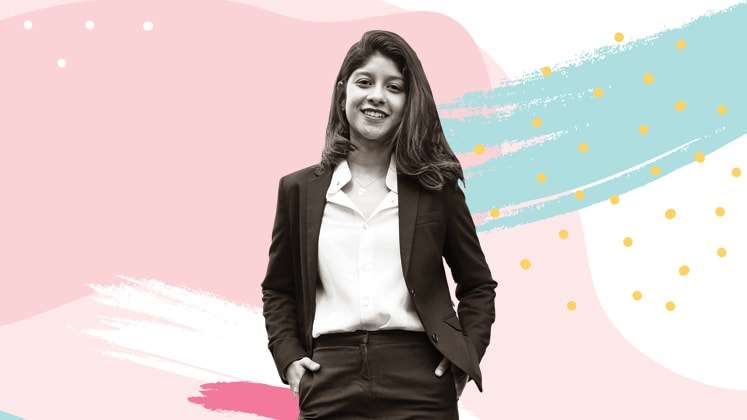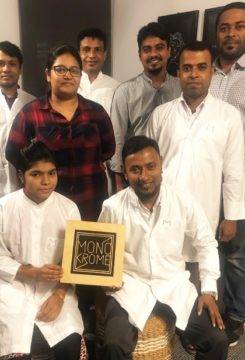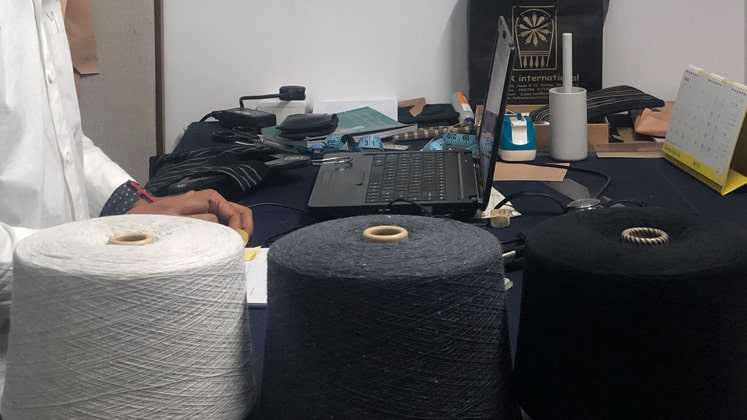
The Bangladesh fashion industry is a growing market. A great number of new home-grown labels are opening up owing to the immense potential and resources available in the skillfully rich country. Sadly, not each one of them come from an educational or monetary background that supports them.
Maheen Khan, Creative Director and Founder of Monokrome – a sustainable fashion start-up, is one such person who has and continues to break outdated perceptions. Having no undergraduate degree in Fashion Designing, Maheen worked in different fields ranging from communication, to education to technology, before finally following her passion and leaping into the world of design.
Two years since launching her own label, the market has exploded and Maheen has observed a growth of 62 per cent which has led her to almost double her team. Apparel Resources (AR) gets candid with the designer on her journey, what drives her, what it took to launch her own label, the importance of marketing in today’s cut-throat scenario and the necessity of industry experience to make a mark in the world of fashion.
AR: What inspired you to launch your own label and choose fashion as a career?
MK : I did not do my degree in fashion – I actually studied Marketing and Demography for my under-graduation, post which I started working in the education sector in Australia; later, I worked with a tech start-up which was a product by the US. This was actually related to the garment industry in Bangladesh, and it required collecting and analysing data from garment workers across Bangladesh. Being the Country Project Manager for it, I travelled across the country going to factories, talking to workers, training them on how to use this platform.
However, I always had an inherent interest in fashion and textiles; it was something that came naturally to me. When it comes to design, I have always been a creative person.
I was in Melbourne, Australia in the beginning of 2017 in January when I went to the National Gallery of Victoria, which was showing a retrospective of these Dutch Designers. I really look up to Viktor & Rolf and the NGV in every respect, but I never got to see their work upfront like that. When I got to see and understand the process of their work, the way they created and the way they came up with designs – I understood that design is not only about the design process but also about the idea behind putting one’s design, and the concept behind a collection.
I was enthralled by it then and that’s when I decided what I am going to be; this experience really pushed me. So, after that, I went to Italy to Polimoda for a month’s training and that really opened my eyes.
AR: What did you study at Polimoda?
MK : I studied Fashion Design. When I look back, I realise that at that stage, I was only academically sound – I did have the talent and the passion but technicalities were not something which I had. At Polimoda, I learned how to make patterns, I learned about fashion and art history and if you talk about the city itself – Florence is like a holy grail of fashion – it’s a mecca of fashion. The teachers were designers in their own regard – they all came from fashion businesses and I got to learn a lot from them.
AR: How did your journey from Italy to Bangladesh shape up? How did Monokrome come into being?
MK : After completing my course in Polimoda, I came back to Dhaka and decided that I am going to start Monokrome. Within a month, I took a place and started hiring people; thus, I began Monokrome in November 2017.
However, I needed a particular concept; I wanted the brand to have a story to tell, to have a philosophy; these were the two things that came to my mind because they represent who I am as a person.
I was deeply interested in sustainability and I wanted to work on very minimal aesthetics, with a Japanese architecture philosophy. So, from the very beginning, I knew it was going to be a brand that caters to customers who want an alternative to fast fashion. I wanted to do slow fashion, I wanted to concentrate and focus on cuts, on textiles, on sourcing and very minimal aesthetics – very simple clothes having very good cuts.
AR: What were some of the things you learnt while you were studying at Polimoda which generally students don’t have access to?
MK : I think one of the most important things I learnt is pattern making, without which fashion design has no meaning.
Especially from where I am, that is Dhaka, Bangladesh, I don’t think we are skilled enough in this domain. When it comes to exporting garments, yes we are pretty great, but when it comes to local designers – they are still not there yet. Pattern making is not something that is extensively used here. You cut the cloth with a free-hand and you don’t really have the measurements. So I learned the importance of pattern making – it was something that was hammered into us during our course in Polimoda. We were taught how to actually cut the paper and cut the fabric in a way to minimise waste.
Another thing that I learned was from the other students that were there from all over the world. It was very interesting to see how they came up with their ideas and designs – some of them were fantastic artists and the way they translated their work into fashion design was absolutely incredible for me to witness. I learned different ways in which one can be creative and I learned to observe – it’s very easy to be a creative person, but for running a business, you have to be very observant.
I would like to mention that the journey has not been easy – I remember when I was in Polimoda, I used to be there from 8 in the morning till 8 at night, constantly working on machines, measuring things and learning.
Polimoda also taught us how to narrow our focus and do the thing that we are best at, because as a creative person when you are starting a business, there is so much you want to do as there are many things that are going on through your mind.
AR: What would you lay greater emphasis on – on-thejob training or a formal education in fashion?
MK : That’s a very good question! It really depends on an individual’s resources. When I was young, I had a very different approach towards the work that I was doing, and in my personal opinion, I really respect training.
I started out without any formal training, but when I did do my training, I didn’t go for the whole three years of education – I went for short training programme. When I completed my course at Polimoda, they asked me to get enrolled, they wanted me to go to school but, obviously I didn’t have the time at that point. I was thirty and I wanted to start my own business, and I had a plan of my own.
But I really feel that if you get some type of formal training and then start the business, it helps a lot. The most I have learned is on-the-job; everything that I do and have been able to achieve it is because of what I have learnt while working. But, I am not going to discount the fact that whatever I have learned in that little time I was in Italy, played a huge role. So I think it’s a mix of both, and you make your choices according to the circumstances in your life.
AR: There is a set amount of capital required to set up your own brand but not everyone is blessed with a good financial background; so what would your advice be to young aspiring students setting out to do so? How can they navigate from being in a college to finally setting up their own brand?
MK : I don’t think one should graduate and set up one’s brand right away. I had 8 years of work experience before I started my business – all of that played a big role when I finally launched Monokrome.
I am a firm believer in experience – you start at the bottom and you work your way to the top and while you are doing that, you save whatever little money you can. Unless of course, you have the resources to jump right into a business and you actually show up – that is great.
I am a very practical person and I feel you should take risks but you should also calculate the amount of risk that you want to take. I think that the experience you get after moving out of college and working for another brand or for another business, plays a big role in cementing you for the future.
AR: What is one of the challenges that you faced while setting up your label and how did you overcome it?
MK : One of the biggest challenges that I have faced with Monokrome is sourcing, because I didn’t know where to source raw materials from. I really had to go out there, research and understand and read a lot. Initially I didn’t know how textiles were woven and I used to visit the places where it was being done.
I was not satisfied with the kind of textiles that were available because they were mainly catering to another market of salwar kameez, kurtis or sarees – they were not catering to shirts or pants. So what I did was primarily, import a lot of textiles, I also worked with suppliers who had a lot of textiles overseas.
I identified a producer of yarns who works with recycled yarns – he collects garment waste from Bangladesh and then makes recycled yarns which are 80 per cent recycled cotton and 20 per cent recycled polyester.
It is a very big challenge if you are a small producer and have small quantities because most producers work with big quantities. I approached him and after many months of back-and-forth of persuasive communication, we finally collaborated and that is what has made Monokrome where it stands today.
I procured yarns from him and worked with weavers in the north of Bangladesh, where I studied the thickness of the fabric. We worked on the number of counts of threads that should go on the weft and the number of counts of threads that should go on the warp; what the design is going to be, what the colour is going to be, and we used natural dyes. All of our accessories were non-plastic; I procured buttons which are wooden, or made out of coconut shells and mother of pearls or bull horns. Even the zippers were steel instead of plastic.

I really wanted to uphold the goal of a transparent supply chain and I succeeded with the quality.
The production happened in my own studio and factory, so that one can see where one’s shirt is being made, where the yarn is coming from, and one knows exactly how everything is achieved.
AR: How can a brand create more awareness – through fashion weeks and trade shows or through digital and social media presence?
MK : Fashion weeks and trade shows are great, but they are also very glamorous and involve big investments. You can never be absolutely sure whether it’s going to give you what you need for your business to survive. At the end of the day, you need to make money if you want to be in business, and you need to make sure that the people you are hiring are getting paid.
For an emerging brand, until and unless you are being invited to showcase and until and unless they are taking interest in you, I don’t see it to be a good investment.
In your initial years, if you have the money to go to trade shows, pick one and go. If you don’t have it, then this is an extreme decision because to take part in a trade show costs a minimum of 2,000-3,000 dollars.
I think you should focus on honing your business, and on increasing sales and making enough money so that one day you can go. After two years of running the business, I don’t have to work for it any more, and I get invited; people are getting in touch with us to know about our work but this didn’t happen when I started off. Slowly through your work and the perseverance to create awareness about your brand, I really feel you will get the attention.
You need to have that strong presence in social media and invest in photography and storytelling. I am very strong on graphics and identity because people identify themselves with a brand.
AR: One thing that you wish the Government can assist in, to make Bangladesh more supportive of homegrown talent?
MK : The Government can aid in more start-up investments; I think there is a programme by them providing investment but I am not sure of that. I think the start-up culture for young people should be encouraged.
We have access to everything, I am lucky that I got to start my business in Dhaka than any other place in the world, because I had access to a lot of resources which are not readily available elsewhere.

AR: What is your take on the current market scenario in Bangladesh?
MK : The Bangladesh fashion industry is a growing market. A positive number of new brands are opening up owing to the immense potential here. The youth population is quite big and in that population pyramid, there are a significant amount of working professionals who cannot be ignored. These young people want to change the game, they want more liberty – especially the women.
With loyal customers ranging from the age of 28 years to the age of 65 years, Monokrome offers sustainable shirts, pants, blazers and coats featuring minimal aesthetics for women.
When I began Monokrome 2 years ago, I had a very small number of customers and it took a lot of convincing power for such a brand to exist in Dhaka because we have a lot of designers and brands that are catering to consumers abroad for their ethnic demand, whether for sarees or for salwar kameez. A brand like Monokrome caters to a completely different group – shirts, pants, blazers, jackets and coats in sustainable textiles for women, featuring minimal aesthetics in a very limited colour palette.
So when I see the growth in my business, I know the market was there but it just hadn’t been tapped, because of the risk it posed since Dhaka people are more conservative and you don’t see them wearing these kind of clothes.

Post a Comment